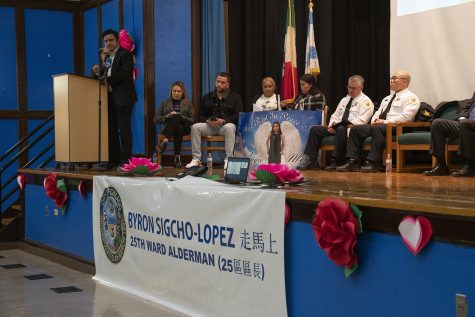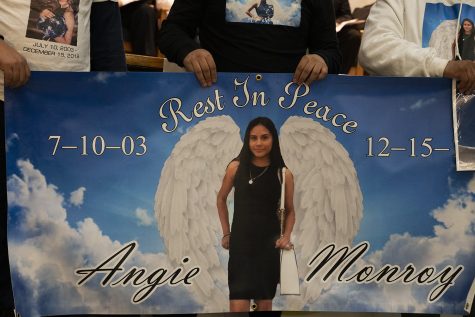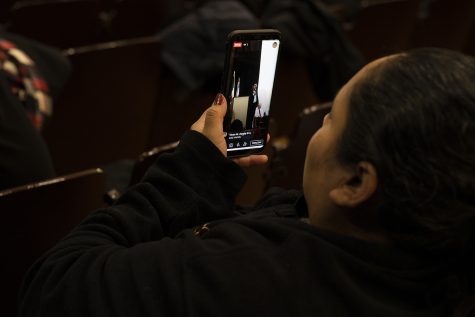Community meeting to address gun violence in Pilsen wracked with conflict

Attendees pack the auditorium of Pickard Elementary, at 2301 W. 21st Place, to hear community organizers and elected representatives address the issue of gun violence in the 25th ward.
Shouts from agitated attendees echoed throughout the Pilsen elementary school auditorium, demanding action and denouncing “politically correct” language from police commanders and elected officials on stage.
Phrases such as “The community is not the police” and “Where is the money?” could be heard repeatedly from residents.
Ald. Byron Sigcho-Lopez (25th Ward), the alderperson representing Pilsen, held a meeting at Pickard Elementary, 2301 W. 21st Place, Thursday, Feb. 20 to create an open line of communication between public servants and citizens in a “long overdue” conversation about how to effectively address gun violence in the community.
More than 100 residents attended the meeting, largely in response to three recent shootings in Pilsen occurring on Saturday, Feb. 8; Sunday, Feb. 9; and Monday, Feb. 10, as well as a double homicide shooting in nearby Chinatown on Sunday, Feb. 9.

Ald. Byron Sigcho-Lopez (25th Ward) addresses town hall attendees Thursday, Feb. 20.
Among those in attendance were Chicago Police Department commanders of the Ogden (10th) and Near West (12th) districts; leaders from nonviolence groups; State Sen. Tony Muñoz (1st District); Cook County Board Commissioner Alma Anaya, who represents the 7th District, including Pilsen; as well as a mother whose 16-year-old daughter was shot and killed. Each offered their own testimony and ideas on how to work together to solve the ongoing gun violence.
“We have heard stories from people who now are moving out of our community because they don’t feel safe anymore,” Sigcho-Lopez said at the meeting. “Gun violence is the worst issue we’re [facing] today.”
Since 2014, there have been approximately 188 shootings in Pilsen alone, according to The Trace, an independent, nonprofit news organization dedicated to coverage of guns in the United States. So far in 2020, 310 people have been shot across the city, as of press time, according to a Chicago Tribune shooting database.
Junior journalism major Melanie Medrano, who was born and raised in Pilsen, said many residents have grown accustomed to witnessing and dealing with gun violence as part of their daily life.

The family of angie Angie Monroy, who was a victim in a drive by shooting in 2019, hold up a banner in her honor.
“Around summertime, if we sit outside our house, we know what the difference between a firework and a gunshot is,” Medrano said. “We know when it’s time to leave and call it a night, and we know when it’s time to just hang out.”
Lucia Villarreal, a 43-year-old Pilsen resident who attended the meeting, said she has witnessed multiple shootings, assisted in imprisoning “violent gang members” and requested more police personnel for the past 20 years—to no avail.
“My house has been shot up three to four times by stray bullets,” Villarreal said. “My daughters … know to this day how to hit the floor when gunfire erupts.”
Sigcho-Lopez said much of Pilsen’s struggle is due to inequalities and a lack of opportunity, mental healthcare, funding and programming.
Andre Rodriguez, a street outreach mentor, said he decided to focus more on Pilsen while working at New Life Centers of Chicagoland—an organization created to address issues such as youth violence, justice system involvement and unemployment. He saw a need for gang intervention, safe spaces and youth resources.

Lucia Villarreal, a 43-year-old Pilsen resident who attended the meeting, stands up to voice her discontent with the way the issue of gun violence has been handled by officials so far.
“When you step outside of Pilsen, the narrative is, ‘They’re gentrified already. They don’t even have a problem,’” Rodriguez said. “But you know that’s not true. I know that’s not true.”
Near West District Cmdr. Stephen Chung said the 12th District is trying to make the community safer by using peace circles; teaching youth alternatives to gangs, guns and drugs; and building trust within the community through schools and organizations such as the Boys and Girls Club.
While fielding protests and complaints from frustrated attendees who felt they were not being heard, Ogden District Cmdr. Gilberto Calderon laid out the Neighborhood Policing Initiative plan, which would have officers patrol their beat on foot so they could listen more closely to residents’ safety concerns.
“If there is anybody in the audience that thinks that we as a police department do not care, you’re wrong,” Calderon said.

A spectator live streams the Pilsen community as Sigcho-Lopez makes closing remarks.
Attendees also posed their own ideas for solutions. One suggested residents apprehend suspected criminals on their own without relying on law enforcement, while others advocated for more funding, youth programs without cops and solidarity with other neighborhoods tackling the same problems.
Sigcho-Lopez said it is important community members listen and advocate for one another so the neighborhood’s needs are heard and proper resources are allocated.
“It’s gonna take a village,” Sigcho-Lopez said. “This is a very tough issue. We really believe that this is just the beginning of this coalition—community groups, the public officials, the commanders—[who will] join us to address this issue.”

